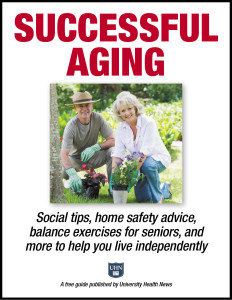Senior Alert Devices Can Save Lives
Staying in one’s own home and living independently is a goal for most people as they age. But for many, medical and physical challenges can present an obstacle to staying home alone. Medical alert devices—known commonly as senior alert devices—are changing that scenario.
If you’re shopping for one for yourself or for your mom or dad, you’ll have to wade through a variety of options, but the bottom line is that the person must commit to wearing and using the device.
A Variety of Senior Alert Devices
Many people remember that old TV commercial featuring a woman lying on the floor in her home and saying, “Help! I’ve fallen and can’t get up.” Simple devices requiring the user to push a button for help have been around since the 1970s. Fast-forward a few decades to today: Senior alert devices have become much more sophisticated with a variety of features and benefits.
The device itself can be a necklace, pendant, bracelet, or clip-on style product. All come with a home base and are connected to a call center for which there is a monthly fee.
Other features include GPS locators and multiple notification alerts sent to designated persons and/or emergency call centers. Some have motion sensors that can detect a fall, prompting an automatic notification of emergency services in the event the person has become unconscious.
Fall detection, of course, is a desired feature, given that the propensity for a fall increases with age. (See also our post “What Is Physical Fitness? How to Keep from Falling Down.”)
Fall detectors are essential in order to provide rapid assistance and to prevent fear of falling and the adverse health consequences. The technology, however, has a way to go. According to a recent study, there is no standardized solution for the complex process of fall detection.
On the horizon, however, is new sensor that promise to make life safer for the elderly, according to developers at SINTEF, an independent Scandinavian research organization. Pressure measurements enable this newly developed fall detector to “observe” falls that current sensors do not register, thus improving safety for older people who live at home. It works by comparing pressure changes between the sensor attached to the user’s body and the other sensors installed around the house.
The pressure measurement technology involved is not new, as such, akin to the way aircraft register changes in altitude, but this is the first time it has been employed in a fall detector.
Retain Your Independence!
Download this expert FREE guide, Successful Aging: Social tips, home safety advice, balance exercises for seniors, and more to help you live independently.
Learn exercises and activities for seniors to keep you safe and let you age in place.
The User Must Use It
Regardless of which senior alert device a user owns, the biggest problem is that he or she won’t wear it, or feels embarrassed to call for help. Encouraging your loved to use a senior alert device may take some time and effort, but it’s important to understand the features (and limitations) of each device.
While these devices can indeed be lifesavers, nothing compares to having a human backup plan in place. A neighbor, a friend, or a healthcare worker who stops by to check in can help keep your loved one safe; a simple phone call can also make all the difference.
Make sure your loved one’s cellphone has emergency contacts that are easily accessible. Consider practicing with your loved to make sure he or she knows how to make and take calls. Sometimes, older people can be frustrated by technology, but with patience and practice, most can learn to use a cellphone, tablet, or senior alert device.
Originally published in April 2016 and updated.
The post Senior Alert Devices Can Save Lives appeared first on University Health News.
Regardless of which senior alert device a user owns, the biggest problem is that he or she won’t wear it, or feels embarrassed to call for help. Encouraging your loved to use a senior alert device may take some time and effort, but it’s important to understand the features (and limitations) of each device.
While these devices can indeed be lifesavers, nothing compares to having a human backup plan in place. A neighbor, a friend, or a healthcare worker who stops by to check in can help keep your loved one safe; a simple phone call can also make all the difference.
Make sure your loved one’s cellphone has emergency contacts that are easily accessible. Consider practicing with your loved to make sure he or she knows how to make and take calls. Sometimes, older people can be frustrated by technology, but with patience and practice, most can learn to use a cellphone, tablet, or senior alert device.
Originally published in April 2016 and updated.
The post Senior Alert Devices Can Save Lives appeared first on University Health News.
Read Original Article: Senior Alert Devices Can Save Lives »
Powered by WPeMatico


